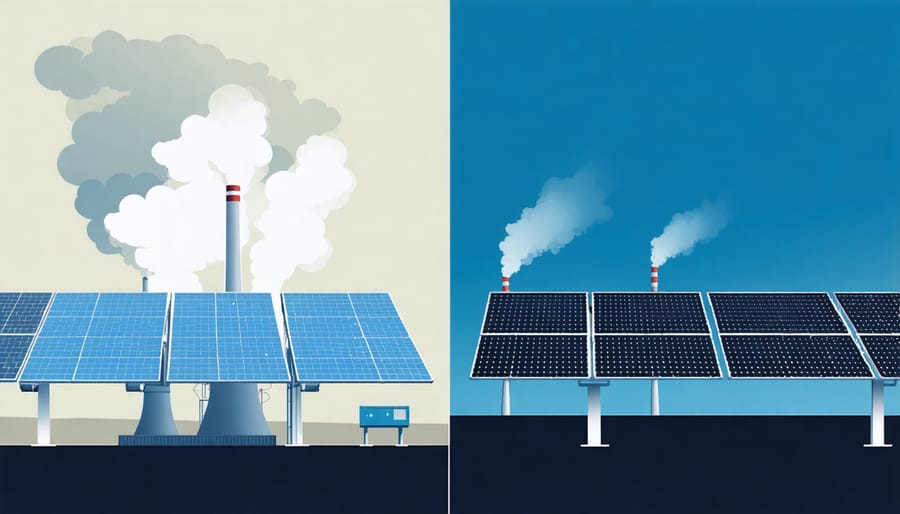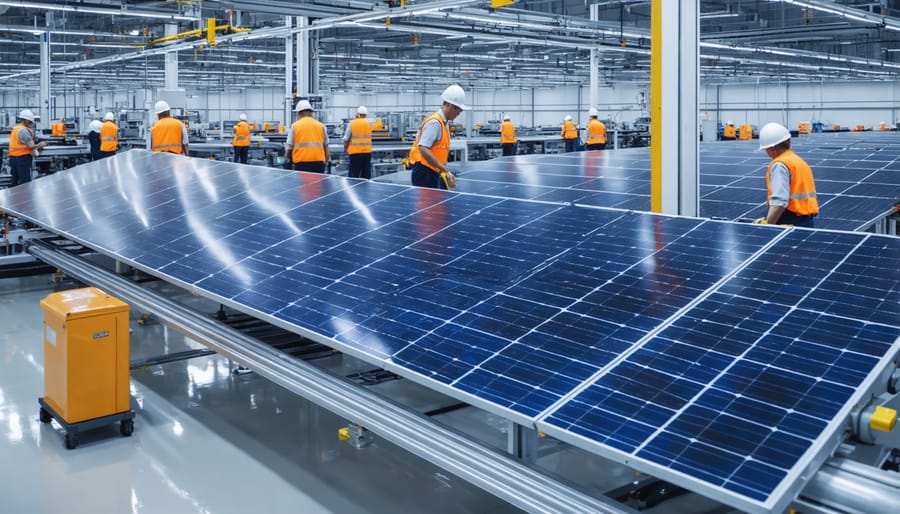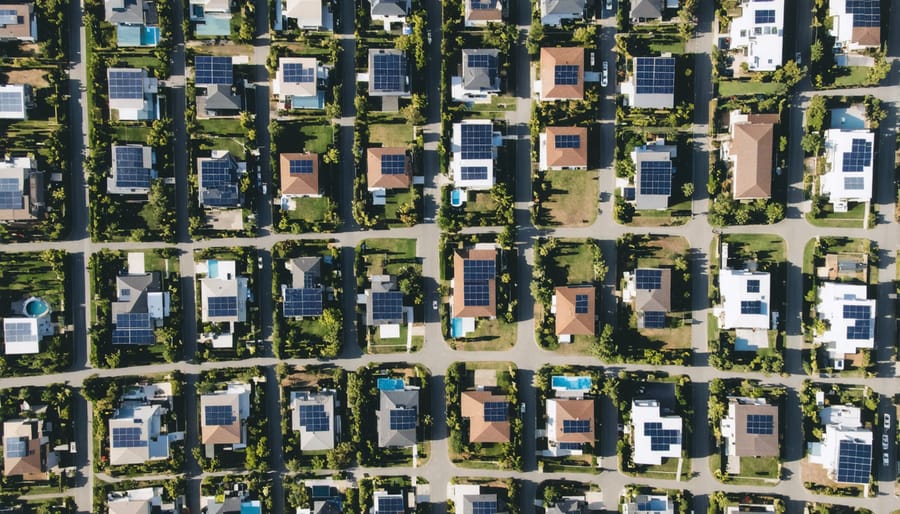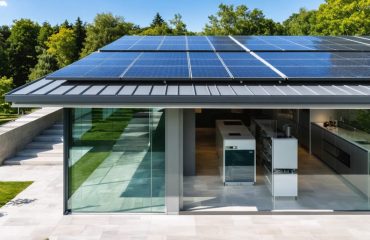Solar energy stands at the forefront of our transition to sustainable power, fundamentally reshaping our environmental footprint in ways both visible and subtle. As sunlight strikes photovoltaic panels across millions of rooftops worldwide, it generates clean electricity without the greenhouse gas emissions that have long been the hallmark of traditional power generation. This revolutionary technology offers a compelling solution to our growing energy needs while addressing urgent climate challenges.
Yet understanding solar energy’s true environmental impact requires looking beyond just clean power generation. From manufacturing processes to end-of-life recycling, solar technology interacts with our environment in complex ways. While the benefits overwhelmingly outweigh the drawbacks, responsible adoption means considering the complete picture – from reduced carbon emissions and improved air quality to land use considerations and material sourcing.
For homeowners and environmentally conscious individuals, grasping these impacts isn’t just about making informed decisions; it’s about participating in one of humanity’s most promising paths toward a sustainable future.
Positive Environmental Benefits of Solar Energy

Reduced Carbon Emissions
Solar energy stands out as one of the most effective ways to save the planet by significantly reducing greenhouse gas emissions. When homeowners switch to solar power, they directly contribute to lowering carbon dioxide emissions that traditionally come from fossil fuel-based electricity generation. A typical residential solar panel system can prevent about 4-5 metric tons of carbon emissions annually – equivalent to planting over 100 trees!
This reduction in carbon emissions happens because solar panels generate electricity without burning fossil fuels. Instead, they harness clean, renewable energy from the sun, producing zero emissions during operation. To put this into perspective, a single home’s solar installation can offset the same amount of carbon dioxide as taking a car off the road for an entire year.
The impact becomes even more significant when considered collectively. As more households adopt solar energy, the cumulative effect creates substantial environmental benefits. In states with high solar adoption rates, carbon emissions from the power sector have dropped dramatically. This shift not only helps combat climate change but also reduces other harmful pollutants associated with traditional power generation, leading to cleaner air and healthier communities.
By choosing solar energy, homeowners become active participants in the global effort to reduce greenhouse gas emissions while enjoying lower energy bills and increased energy independence.
Conservation of Water Resources
One of solar energy’s most significant environmental benefits is its minimal water consumption compared to traditional power generation methods. While conventional power plants require massive amounts of water for cooling and steam production, solar panels operate without any water for their primary electricity generation process.
To put this into perspective, a typical coal or nuclear power plant uses between 20,000 to 60,000 gallons of water per megawatt-hour of electricity produced. In contrast, solar photovoltaic systems use virtually no water during operation, only requiring occasional cleaning to maintain efficiency.
Even in areas where panels need cleaning, innovative waterless cleaning solutions and robotic systems are becoming more common, further reducing water requirements. For utility-scale solar installations that use concentrated solar power (CSP) technology, water consumption is still significantly lower than fossil fuel alternatives, especially when dry-cooling systems are implemented.
This water conservation aspect is particularly crucial in drought-prone regions and areas with limited water resources. By transitioning to solar power, communities can redirect precious water resources to other essential needs like agriculture and drinking water supplies. The reduced strain on local water resources also helps protect aquatic ecosystems and ensures more sustainable water management for future generations.
Environmental Considerations During Solar Panel Lifecycle
Manufacturing Impact and Solutions
While solar energy offers significant environmental benefits during operation, it’s important to acknowledge the manufacturing process’s environmental impact. The production of solar panels requires energy, raw materials, and industrial processes that can contribute to carbon emissions and resource consumption.
However, the solar industry has made remarkable strides in reducing its manufacturing footprint. Modern production facilities are increasingly powered by renewable energy, and manufacturers are developing more efficient processes that require fewer raw materials. Many companies now use recycled silicon and other materials, significantly reducing the environmental impact of panel production.
The energy payback time – how long it takes for a solar panel to generate the amount of energy used in its production – has decreased dramatically. Today’s high-performance solar home systems typically offset their manufacturing energy within 1-4 years, while their operational lifespan extends to 25-30 years.
Innovation in the industry continues to drive improvements. New technologies are reducing the need for rare earth materials, and manufacturers are developing panels that are both more efficient and less resource-intensive to produce. Additionally, the emergence of solar panel recycling programs helps recover valuable materials and reduce waste, creating a more circular economy for solar technology.
These manufacturing improvements, combined with the long operational life of solar panels, mean that the overall environmental benefits far outweigh the initial production impact. As production methods continue to become more sustainable, solar energy’s role in combating climate change only grows stronger.

End-of-Life Recycling and Innovation
As solar panels reach the end of their 25-30 year lifespan, the solar industry is making significant strides in recycling and sustainable disposal practices. Modern solar panels are about 95% recyclable, with valuable materials like glass, aluminum, copper, and silicon that can be recovered and reused in new panels or other products.
Many manufacturers now operate take-back programs, making it easier for homeowners to responsibly dispose of their old panels. These programs ensure that valuable materials don’t end up in landfills and instead get a second life in the manufacturing chain. Some companies are even designing their panels with recycling in mind, using materials and construction methods that make dismantling and material recovery more efficient.
Innovative recycling technologies are emerging that can recover more materials with less energy input. For example, new thermal and chemical processes can separate and purify silicon cells more effectively than traditional mechanical methods. These advances are making solar panel recycling more cost-effective and environmentally friendly.
The recycling industry for solar panels is growing rapidly, creating new jobs and business opportunities while reducing waste. Several states have already implemented regulations requiring proper disposal and recycling of solar panels, and more are expected to follow suit. This regulatory framework, combined with improving technology and increasing scale, is helping to make solar energy even more sustainable throughout its entire lifecycle.
As recycling programs become more widespread and efficient, the environmental impact of solar energy continues to decrease, making it an increasingly attractive option for environmentally conscious homeowners.
Building Environmental Resilience Through Solar
Grid Independence and Environmental Protection
Solar energy plays a crucial role in reducing strain on traditional power grids while helping to build environmental resilience. When homeowners generate their own solar power, they decrease demand on centralized power plants, which often rely on fossil fuels and require extensive infrastructure maintenance. This distributed energy generation model creates a more flexible and reliable power system, reducing the need for new transmission lines and power plants.
The environmental benefits extend beyond grid relief. Solar energy systems help preserve natural resources by reducing water consumption typically needed for cooling traditional power plants. Unlike conventional power generation, solar panels operate without requiring continuous water resources, making them particularly valuable in drought-prone regions.
Additionally, solar installations can protect local ecosystems by minimizing land disturbance compared to fossil fuel extraction. When installed on existing structures like rooftops, solar panels make efficient use of already-developed spaces without requiring additional land clearing. This approach helps preserve natural habitats while generating clean energy, creating a win-win situation for both homeowners and the environment.

Future-Proofing Our Environment
The widespread adoption of solar energy represents a crucial step toward a more sustainable future. As more homeowners and businesses transition to solar power, we’re creating a domino effect of positive environmental changes that will benefit generations to come. Each new solar installation contributes to reducing our collective carbon footprint and decreasing our dependence on fossil fuels.
Looking ahead, solar technology continues to improve in efficiency and affordability, making it an increasingly viable solution for clean energy production. These advancements, coupled with growing adoption rates, are helping to create a more resilient power grid that’s less vulnerable to climate-related disruptions and fossil fuel price fluctuations.
The environmental benefits of solar energy compound over time. As more people switch to solar power, we see a cascading effect of reduced air pollution, decreased water consumption in energy production, and lower greenhouse gas emissions. This transition also helps preserve natural habitats by reducing the need for resource extraction and limiting the environmental damage associated with traditional energy sources.
Moreover, solar energy plays a vital role in building sustainable communities and creating green jobs, fostering an economy that values environmental stewardship alongside economic growth.
Solar energy stands as a powerful solution for creating a more sustainable future while offering immediate benefits for homeowners. By harnessing the sun’s power, we can significantly reduce greenhouse gas emissions, minimize water pollution, and preserve precious natural resources for future generations. The environmental advantages extend beyond individual households to benefit entire communities through improved air quality and reduced strain on local power grids. Making the switch to solar not only helps protect our planet but also offers substantial financial savings through reduced energy bills and available tax incentives. As climate change continues to pose challenges, every homeowner has the opportunity to be part of the solution. By investing in solar energy today, you’re not just reducing your carbon footprint – you’re joining a growing movement of environmentally conscious individuals working towards a cleaner, more sustainable world for generations to come.









